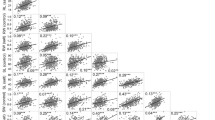Abstract
Sodium transport in rice is characterised by large variability between individual plants, and large environmental interaction. As a result of these two factors, plant sodium content is a continuous variable which is not distributed normally. This applies both to the quantity of sodium in the plant and to the concentration of sodium on a unit fresh or dry weight basis. This variability is in part because the transpirational by-pass flow, dependent upon root anatomy and development, contributes to sodium uptake. Variability in sodium content within designated cultivars is heritable and line selections diverge during recurrent selection, suggesting that selection is working on residual heterozygosity rather than on a family of homozygous lines. Varieties differ in average sodium uptake into the plant but the direct correlation of this with survival is weak. This is because other independent characters are important (and these have not been combined by natural selection nor by chance) and because overall performance is confounded by the spurious advantage of the tall (non-dwarf) plant type. This advantage is spurious because much of it is due to plant size rather than to any genetic information for salt tolerance. The benefit deriving from plant size will not be heritable in crosses with genotypes of the improved (dwarf), high-yielding plant type because the dwarfing genes are dominant. Sodium transport is heritable in crosses, and the results presented show that both low sodium transport and low sodium to potassium ratio can be selected independently of plant type. This allows the selection of dwarf plants (which are agronomically desirable) with low sodium transport (which will improve salt tolerance).
Similar content being viewed by others
References
Akbar M 1986 Breeding for salinity tolerance in rice. In Salt-affected Soils of Pakistan, India and Thailand. Eds. IRRI. pp 39–63. International Rice Research Institute, Los Baños, The Philippines.
Dumbroff E B and Pierson D R 1971 Probable sites for passive movement of ions across the endodermis. Can. J. Bot. 49, 35–38.
Flowers T J and Yeo A R 1981 Variability in the resistance of sodium chloride salinity within rice varieties. New Phytol. 88, 363–373.
Flowers T J, Hajibagheri M A and Yeo A R 1991 Ion accumulation in the cell walls of rice plants growing under saline conditions: Evidence for the Oertli hypothesis. Plant Cell Environ. 14, 319–325.
Flowers T J, Salama F M and Yeo A R 1988 Water use efficiency in rice (Oryza sativa L.) in relation to resistance to salinity. Plant Cell Environ. 11, 453–459.
Gorham J, Hardy C A, Wyn Jones R G, Joppa L R and Law C N 1987 Chromosomal location of a K/Na discrimination character in the D genome of wheat. Theor. Appl. Gen. 74, 584–588.
Jones M P and Wilkins D A 1984 Screening for salinity tolerance by rapid generation advance. I.R.R.I. Newsl. 9, 9–10.
Oka H I 1988 Origin of Cultivated Rice. Japan Scientific Societies Press, Tokyo. 254 p.
Peterson C A, Emanuel M E and Humphreys G B 1981 Pathways of movement of apoplastic dye tracers through the endodermis at the site of secondary root formation in corn (Zea mays) and broad bean (Vicia faba). Can. J. Bot. 59, 618–625.
Pitman M G 1982 Transport across plant roots. Q. Rev. Biophys. 15, 481–554.
Poehlman J M 1987 Breeding Field Crops (Third Edition). Van Nostrand Reinhold, New York.
Richards R A 1983 Should selection for yield in saline regions be made on saline or non-saline soils? Euphytica 32, 431–438.
Sanderson J 1983 Water uptake by different regions of the barley root: Pathways of radial flow in relation to development of the endodermis. Plant Cell Environ 8, 309–315.
Simmonds N W 1979 Principles of Crop Improvement. Longman, London and New York.
Yeo A R and Flowers T J 1986 Salinity resistance in rice (Oryza sativa L.) and a pyramiding approach to breeding varieties for saline soils. Aust. J. Plant Physiol. 13, 161–173.
Yeo A R, Yeo M E and Flowers T J 1987 The contribution of an apoplastic pathway to sodium uptake by rice roots in saline conditions. J. Exp. Bot. 38, 1141–1153.
Yeo A R, Yeo M E and Flowers T J 1988 Selection of lines with high and low sodium transport within varieties of an inbreeding species; rice (Oryza sativa L.). New Phytol. 110, 13–19.
Yeo A R, Yeo M E, Flowers S A and Flowers T J 1990 Screening of rice (Oryza sativa L.) genotypes for physiological characters contributing to salinity resistance, and their relationship to overall performance. Theor. Appl. Gen. 79, 377–384.
Yeo A R, Lee K-S, Izard P, Boursier P J and Flowers T J 1991 Short- and long-term effects of salinity on leaf growth in rice (Oryza sativa L.). J. Exp. Bot. 42, 881–889.
Yoshida S, Forno D A, Cock J H and Gomez K A 1976 Laboratory Manual for Physiological Studies of Rice (Third Edition). International Rice Research Institute, Los Baños, The Philippines.
Author information
Authors and Affiliations
Rights and permissions
About this article
Cite this article
Yeo, A.R. Variation and inheritance of sodium transport in rice. Plant Soil 146, 109–116 (1992). https://doi.org/10.1007/BF00012002
Issue Date:
DOI: https://doi.org/10.1007/BF00012002




